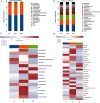Human gut microbiota adaptation to high-altitude exposure: longitudinal analysis over acute and prolonged periods
- PMID: 40257273
- PMCID: PMC12131729
- DOI: 10.1128/spectrum.02916-24
Human gut microbiota adaptation to high-altitude exposure: longitudinal analysis over acute and prolonged periods
Abstract
This study investigated the longitudinal effects of acute (7-day) and prolonged (3-month) high-altitude exposure on gut microbiota in healthy adult males, addressing the limited data available in human populations. A cohort of 406 healthy adult males was followed, and fecal samples were collected at three time points: baseline at 800 m (406 samples), 7 days after ascending to 4,500 m (406 samples), and 2 weeks post-return to 800 m following 3 months at high altitude (186 samples). High-throughput 16S ribosomal DNA sequencing was employed to analyze microbiota composition and diversity. Results revealed significant changes in alpha- and beta-diversity, with acute high-altitude exposure inducing more pronounced effects compared to prolonged exposure. Specifically, acute exposure increased opportunistic pathogens (Ruminococcus and Oscillibacter) but decreased beneficial short-chain fatty acid producers (Faecalibacterium and Bifidobacterium). Notably, these changes in microbiota persisted even after returning to low altitude, indicating long-term remodeling. Functional analyses revealed substantial changes in metabolic pathways, suggesting microbiota-driven adaptations to energy utilization under high-altitude hypoxic conditions. In summary, acute high-altitude exposure caused dramatic changes in gut microbiota, while prolonged exposure led to structural and functional reshaping. These findings enhance our understanding of how high-altitude environments reshape gut microbiota.
Importance: This study is the first to investigate the impact of high-altitude exposure on gut microbiota adaptation in a large-scale longitudinal cohort. It seeks to enhance understanding of how high-altitude environments reshape gut microbiota. Acute exposure to high altitude significantly affected both α-diversity and β-diversity of gut microbiota, with acute exposure causing more pronounced changes than prolonged adaptation, indicating temporary disruptions in microbial communities. Notable shifts in microbial abundance were observed, including increased levels of genera linked to hypoxic stress (e.g., Gemmiger, Ruminococcus, and Parabacteroides) and decreased levels of beneficial bacteria (e.g., Faecalibacterium, Roseburia, and Bifidobacterium), suggesting possible adverse health effects. Functional analysis indicated changes in metabolism-related pathways post-exposure, supporting the idea that high-altitude adaptations involve metabolic adjustments for energy management. These findings enhance understanding of high-altitude physiology, illustrating the role of gut microbiota in hypoxic health.
Keywords: 16S rDNA; dysbacteriosis; gut microbiota; high altitude; longitudinal effects.
Conflict of interest statement
The authors declare no conflict of interest.
Figures







Similar articles
-
Intermittent fasting driven different adaptive strategies in Eothenomys miletus (Red-backed vole) at different altitudes: based on the patterns of variations in intestinal microbiota.BMC Microbiol. 2025 Mar 31;25(1):185. doi: 10.1186/s12866-025-03934-4. BMC Microbiol. 2025. PMID: 40165055 Free PMC article.
-
Responses of gut microbiota to altitude in a small mammal on Qinghai-Tibetan Plateau.Comp Biochem Physiol Part D Genomics Proteomics. 2025 Sep;55:101467. doi: 10.1016/j.cbd.2025.101467. Epub 2025 Mar 6. Comp Biochem Physiol Part D Genomics Proteomics. 2025. PMID: 40068441
-
Strawberry dietary intervention influences diversity and increases abundances of SCFA-producing bacteria in healthy elderly people.Microbiol Spectr. 2025 Feb 4;13(2):e0191324. doi: 10.1128/spectrum.01913-24. Epub 2025 Jan 8. Microbiol Spectr. 2025. PMID: 39772703 Free PMC article. Clinical Trial.
-
Extreme winter environment dominates gut microbiota and metabolome of white-lipped deer.Microbiol Res. 2025 Aug;297:128182. doi: 10.1016/j.micres.2025.128182. Epub 2025 Apr 15. Microbiol Res. 2025. PMID: 40252261
-
Exposure to high altitude leads to disturbances in host metabolic homeostasis: study of the effects of hypoxia-reoxygenation and the associations between the microbiome and metabolome.mSystems. 2025 May 20;10(5):e0134724. doi: 10.1128/msystems.01347-24. Epub 2025 Apr 16. mSystems. 2025. PMID: 40237534 Free PMC article.
Cited by
-
Lactobacillus johnsonii HL79 mitigate plateau environment-induced hippocampal dysfunction in mice.AMB Express. 2025 Jun 19;15(1):96. doi: 10.1186/s13568-025-01898-2. AMB Express. 2025. PMID: 40536601 Free PMC article.
References
MeSH terms
Substances
Grants and funding
LinkOut - more resources
Full Text Sources

